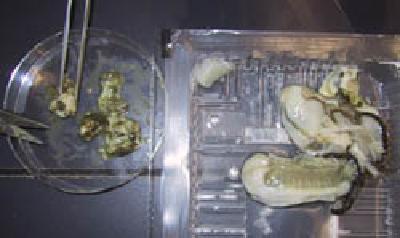Here's the text.
Virus test
Last update date April 2, 2024
Food poisoning and Virus
Viruses that cause food poisoning include hepatitis A virus, rotavirus, and adenovirus, but a typical one is norovirus.
In the food poisoning outbreak situation nationwide in 2015, food poisoning due to norovirus ranks first in terms of the number of cases and the number of patients by etiological substance.
About norovirus
Norovirus multiplies in the human intestinal mucosa and causes symptoms such as nausea, vomiting, acute diarrhea ( gastroenteritis), and abdominal pain.
After infection, symptoms usually appear after an incubation period of 24 to 48 hours (the time from infection to onset), and most recover within 3 days. Outbreaks occur throughout the year, but occurs frequently in winter (approximately December to March).
Because norovirus does not have a vaccine, treatment is limited to symptomatic treatment.
There are various cases of infection routes as follows.
- Norovirus in human feces flows into the sea through sewage treatment plants and rivers, accumulates in the middle bowel glands of bivalves such as oysters, and ate the shell without sufficient cooking.
- Cases where food is contaminating food through cooking workers (mainly hands, etc.) infected with norovirus
- Infections directly from patients' vomit and excrement without food.
- Cases of direct droplet infection from person to person at home or in co-operated facility
In particular, there have been many cases involving food handlers, such as 2. Food handlers need special attention because norovirus can be subclinically transmitted (not showing symptoms even if infected).

Raw oysters and the middle bowel glands
Points of prevention
- Cook the ingredients (90 seconds or more at a center temperature of 85-90°C)
- Encourage your hands
- Do not engage in cooking if you have symptoms such as diarrhea or vomiting.
- Use clean equipment and containers
(Sodium hypochlorite (chlorine concentration: 200 ppm) is effective for inactivating the virus.)
- Make it a habit to wear disposable gloves and properly replace disposable gloves during work such as serving and serving.
- The vomit and excrement are sanitarily treated and disinfected
For inquiries to this page
Medical Care Bureau Health and Safety Department Central Wholesale Market Home Food Sanitation Laboratory
Phone: 045-441-1153
Phone: 045-441-1153
Fax: 045-441-8009
Email address: ir-honjo@city.yokohama.jp
Page ID: 388-594-552







